生物炭对土壤氮循环的影响研究进展
2016-11-28王洪媛盖霞普翟丽梅刘宏斌
王洪媛, 盖霞普, 翟丽梅, 刘宏斌
中国农业科学院农业资源与农业区划研究所, 农业部面源污染控制重点实验室,北京 100081
生物炭对土壤氮循环的影响研究进展
王洪媛, 盖霞普, 翟丽梅, 刘宏斌*
中国农业科学院农业资源与农业区划研究所, 农业部面源污染控制重点实验室,北京 100081

生物炭;土壤氮循环;文献计量学
科学界对生物炭的研究源于南美亚马逊盆地黑土(Terra Preta)的发现[1]。生物炭是指在无氧或少氧条件下各种生物质(木材、草、玉米秆、麦秆、种壳、粪便、树叶等)经过高温处理,部分生物质转化为油和气后产生的一类富碳产物[2]。生物炭含碳量丰富,具有高度的物理稳定性、生物化学抗分解性[2- 3]以及具有较大的比表面积、多孔结构[4]等优良特性,不但有利于农田土壤固持养分,提高养分利用率[5- 6],而且储存于土壤,能大幅度提升土壤碳库,是碳封存的一个重要手段[7- 9]。另外,有研究指出生物炭能够减少N2O和CH4等温室气体的排放[10],Wolf等[11]认为,全面应用生物炭能够削减12%的人为产生温室气体(CO2、CH4、N2O)。

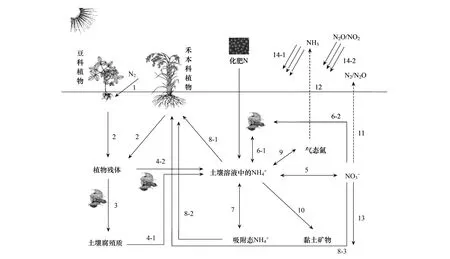
图1 土壤氮循环示意图[12]Fig.1 The diagram of soil nitrogen cycling[12]1: 生物固氮;2: 有机氮归还; 3: 腐殖化; 4- 1: 土壤腐殖质矿化; 4- 2: 植物残体分解; 5: 自养硝化作用; 6- 1: 铵态氮固持; 6- 2: 硝态氮固持的吸附与解;吸8- 1: 溶液的吸收; 8- 2: 吸附态的吸收; 8- 3: 硝态氮的吸收; 9: 土壤中液/气相氨的平衡的固定; 11: 反硝化作用; 12: 氨挥发的淋洗; 14- 1: 氨沉降; 14- 2: 大气硝酸盐沉降
因此,本文基于ISI Web of Science数据库,采用文献计量学方法,针对“生物炭对土壤氮循环影响”及其分支技术进行文献检索、数据整理、分类以及主题分析,并对检索出的文献进行两个层面的分析:一是整体态势分析,主要是对该领域全部年数据进行轮廓性的年代、国家、机构和期刊分布分析;二是具体分支技术分析,详细介绍分支技术的研究发展现状及趋势。
1 整体态势分析
以ISI Web of Science数据库中全部期刊为检索对象,检索时间截止到2014年6月,检索关键词为“biochar/charcoal/blackchar/black carbon” and “nitrogen cycling/nitrogen-cycling”,共检索到2468篇论文。其中,期刊论文(Article)2188篇、综述性论文(Review)93篇,其它类论文177篇。对检索出的文献数据采用美国汤森路透公司文献分析工具Thomson data analyzer(简称TDA)和Excel 2010进行分析。
1.1 年代分布
从图2可以看出,20世纪初就有关于生物炭对土壤氮循环影响的研究报道,发文量呈持续增长的发展态势,但前期发展缓慢,年发文量均在10篇以下;进入20世纪90年代后,相关研究发文量增长迅速,年增长率平均在15%左右,2013年年发文量突破260篇。可见,随着全球气候变化加剧,粮食及生态环境安全更加严重,尤其是目前严峻的氮肥资源紧缺及水体富营养化的形势,越来越多的专家开始关注生物炭对土壤氮循环过程的影响作用[15- 17]。
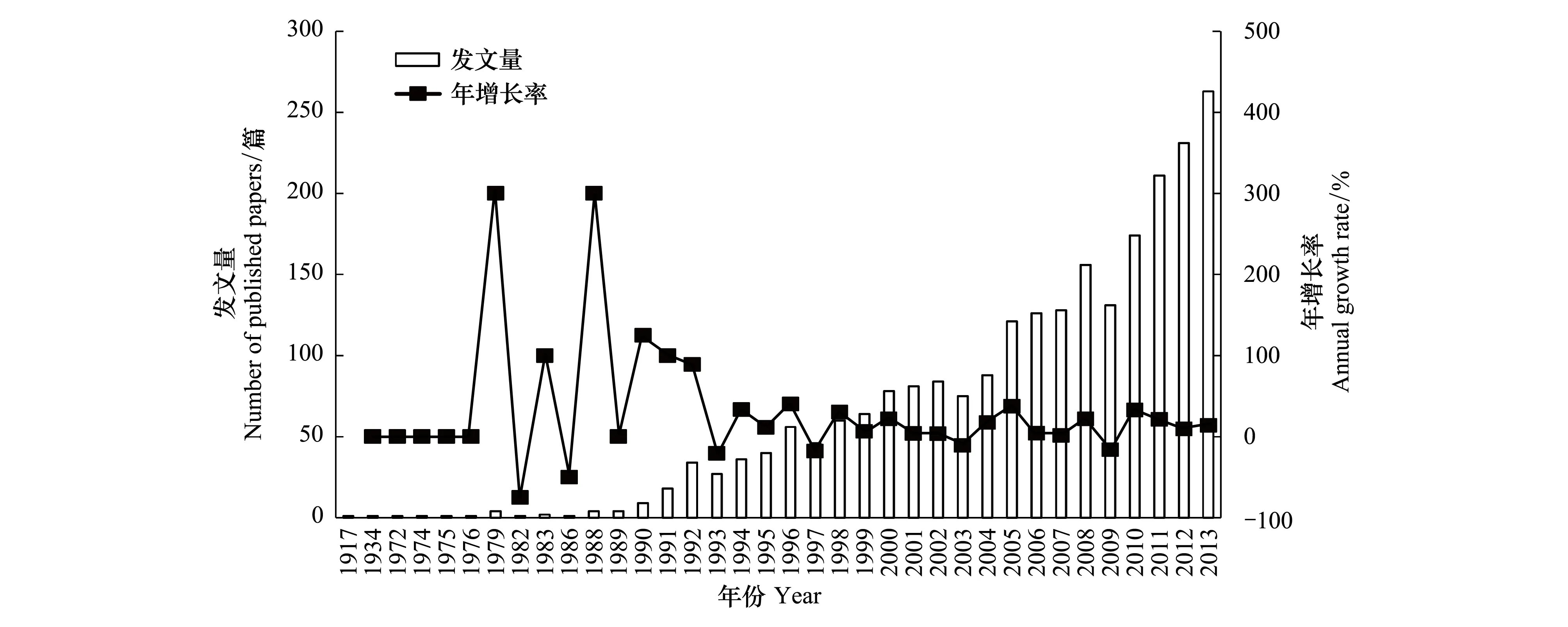
图2 生物炭对土壤氮循环的影响主题SCI论文年代分布Fig.2 The time distribution of SCI papers about the effect of biochar on the soil nitrogen cycling
1.2 国家(或地区)分布
全球共有100多个国家/地区开展了生物炭对土壤氮循环影响的研究,其中前20位的国家排名见图3。发文量名列前10位的国家分别是美国、中国、加拿大、英国、德国、日本、新西兰、荷兰、丹麦和印度,占发文总量的85.2%。尤其,美国在该主题的研究中占有绝对优势,其发文量占全部论文的19.6%;中国在该领域的发文量排名第2,发文量占总量的13.4%。
从研究区域上看,欧洲在生物炭对土壤氮循环影响的研究中占有明显的优势,整体实力雄厚,排名进入前20位的欧洲国家有英国、德国、荷兰、丹麦、法国、瑞典、意大利、比利时和奥地利,发文量占总量的39.7%;北美洲次之,美国和加拿大的发文量占总量的28.4%;东亚的中国和日本,发文量占总量的21.2%。

图3 生物炭对土壤氮循环的影响主题SCI论文国家/地区分布Fig.3 The country/region distribution of SCI papers about the effect of biochar on the soil nitrogen cycling
从图4中可以看出,发文量前4位国家中,美国最早在生物炭对土壤氮循环的影响方面开展相关研究,可追溯到1917年,其年发文量处于全球领先地位,并持续到2010年。进入20世纪90年代后,加拿大和英国相继进入该研究领域,年发文量呈波动上升的态势。在全球良好的科研环境条件下,虽然中国起步较晚,但起点较高、发展势头强劲,近年来,中国的年发文量已超过美国,成为全球第一的年发文大国。

图4 生物炭对土壤氮循环的影响主题SCI论文前4位国家年代分布Fig.4 The time distribution of the former four countries of SCI papers about the effect of biochar on the soil nitrogen cycling
1.3 研究机构分布
全球有1500多家研究机构活跃在生物炭对土壤氮循环影响的研究领域。在前20位研究机构中(表1),中国和美国各4家,加拿大和新西兰各3家,丹麦、日本和英国各2家,荷兰、法国、瑞典和德国各有1家。排名前5位的研究机构依次是中国科学院、加拿大农业与农产食品部(Agriculture and Agri-Food Canada,AAFC)、美国农业部农业研究服务署(USDA,ARS)、新西兰林肯大学(Lincoln University,LC)和荷兰瓦赫宁根大学及研究中心(Wageningen University and Research Center,UWRC)。其中,中国科学院的发文量最多,达158篇,远远领先于其他研究机构,为该研究领域的第一研究梯队;加拿大农业与农产食品部与美国农业部农业研究服务署的发文量相当,分别为119篇和118篇,形成了该研究领域的第二研究梯队。进入排名前20位的中国研究机构还有南京农业大学、中国农业科学院和中国农业大学,分别排在第10、13位和第15位。另外,浙江大学以17篇的发文量排在全球第35位。
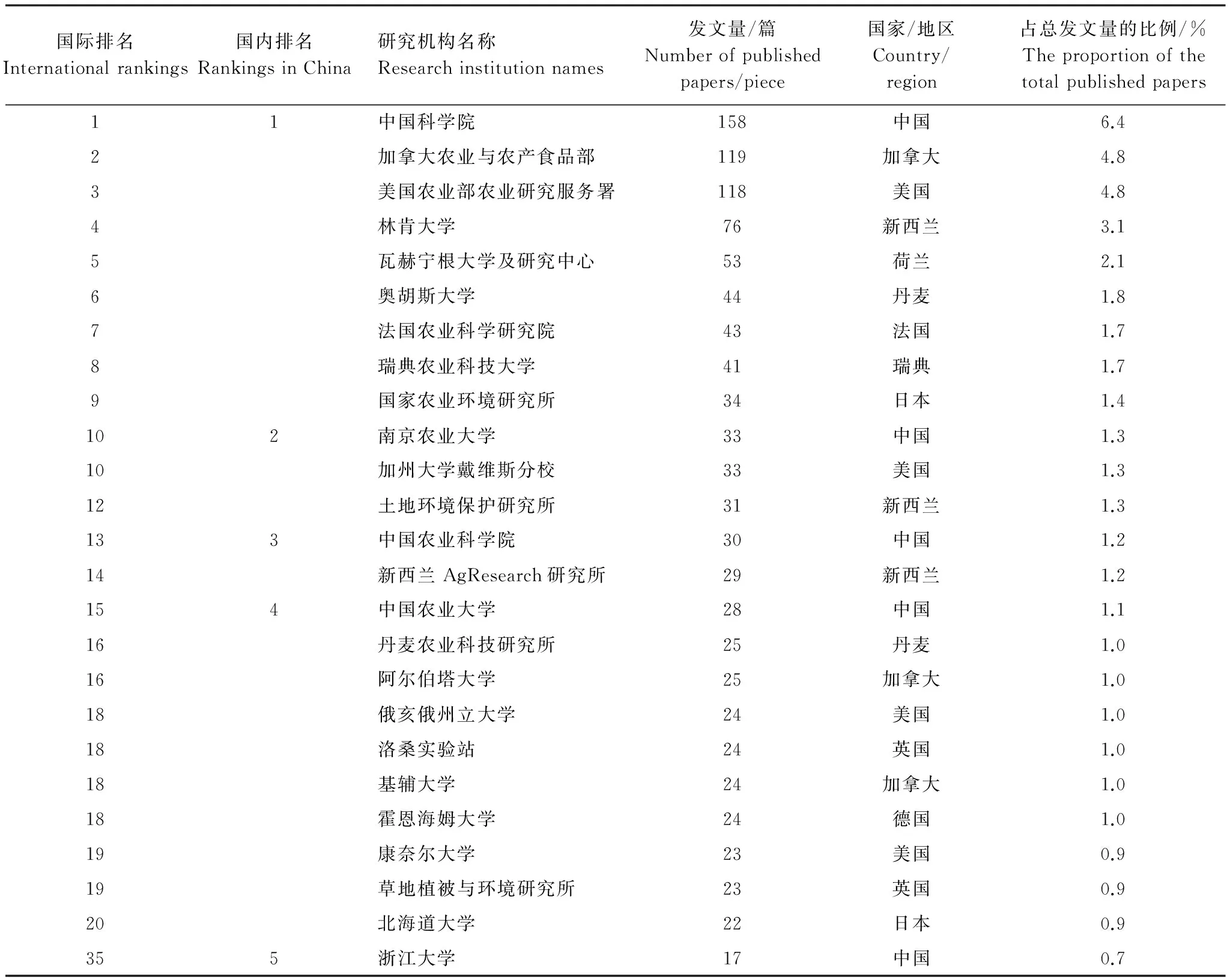
表1 生物炭对土壤氮循环的影响主题SCI论文研究机构分布

图5 生物炭对土壤氮循环的影响主题SCI论文前5位机构年代分布Fig.5 The research institutions distribution of the former five countries of SCI papers about the effect of biochar on the soil nitrogen cycling
分析国际前5位研究机构历年发文情况(图5),20世纪90年代初期各研究机构在生物炭对土壤氮循环影响方面的研究均处于起步阶段;90年代中后期,各机构的发文量开始增长。由图5可以看出,加拿大农业与农产食品部(AAFC)最早开展相关研究,其次为美国农业部农业研究服务署(ARS),中国科学院(CAS)在90年代末期开展了相关研究,近年来发展迅速。
国内排名相对靠前的前5位研究机构分别是中国科学院、南京农业大学、中国农业科学院、中国农业大学和浙江大学。由图6的机构-年发文量情况可以看出,中国科学院和中国农业科学院最早开展相关研究。另外,中国科学院和南京农业大学的年发文量呈现连续性的特征,而其余研究机构的相关研究时断时续。
1.4 期刊分布
该主题发表的论文涉及期刊近500种,发文量前20位期刊情况见表2。其中,发文量最多的前5种期刊分别是:SOIL BIOLOGY & BIOCHEMISTRY(127篇)、AGRICULTURE ECOSYSTEMS & ENVIRONMENT(124篇)、NUTRIENT CYCLING IN AGROECOSYSTEMS(105篇)、JOURNAL OF ENVIRONMENTAL QUALITY(99篇)和PLANT AND SOIL(88篇)。该5种期刊的平均影响因子为2.985(2015年),其中,SOIL BIOLOGY & BIOCHEMISTRY和AGRICULTURE ECOSYSTEMS & ENVIRONMENT两种期刊2015年影响因子均在3.2以上。
综上所述,自20世纪90年代后,国际上越来越多的专家开始关注生物炭对土壤氮素迁移转化过程的影响作用,有1500多家研究机构活跃在生物炭对土壤氮循环影响作用研究领域。美国、加拿大、英国等欧美国家在该领域的研究中占有明显的优势,而自2010年以来,中国已成为该领域全球第一的年发文大国。

图6 生物炭对土壤氮循环的影响主题SCI论文前5位中国机构-年代分布Fig.6 The research institutions distribution of the former five countries of SCI papers about the effect of biochar on the soil nitrogen cycling in China
2 分支技术分析

2.1 论文发表情况
图7可以看出,生物炭对土壤N2O排放的影响方面发文量最多,为1237篇,占总发文量的50.1%;其次是生物炭对土壤氮肥利用率的影响主题,发文量为582篇,占总发文量的23.6%;生物炭对土壤硝化速率的影响主题的发文量为280篇,排在第3位;其余3类分支技术的发文量相对较少,在150篇以下。
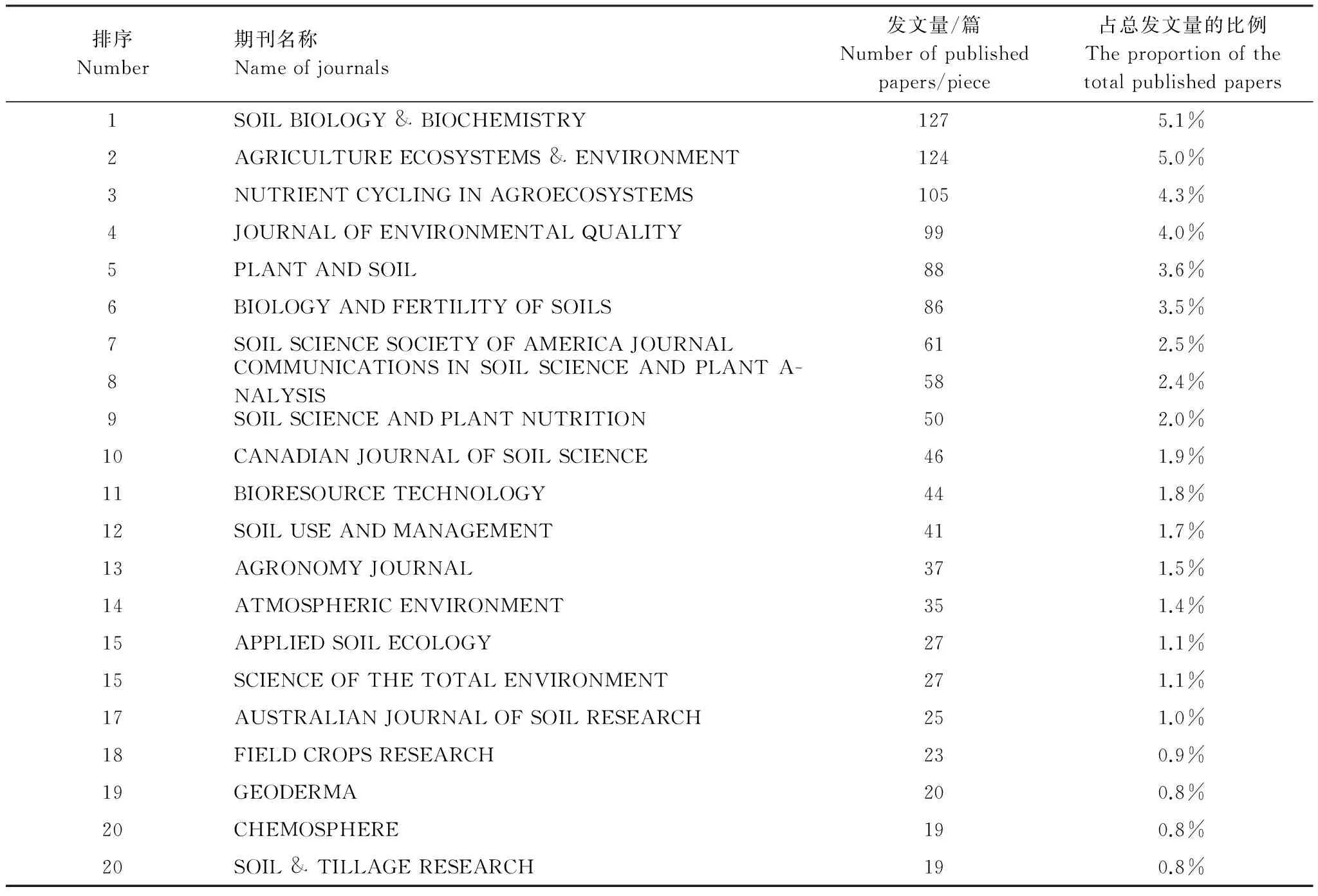
表2 生物炭对土壤氮循环的影响主题SCI论文期刊分布
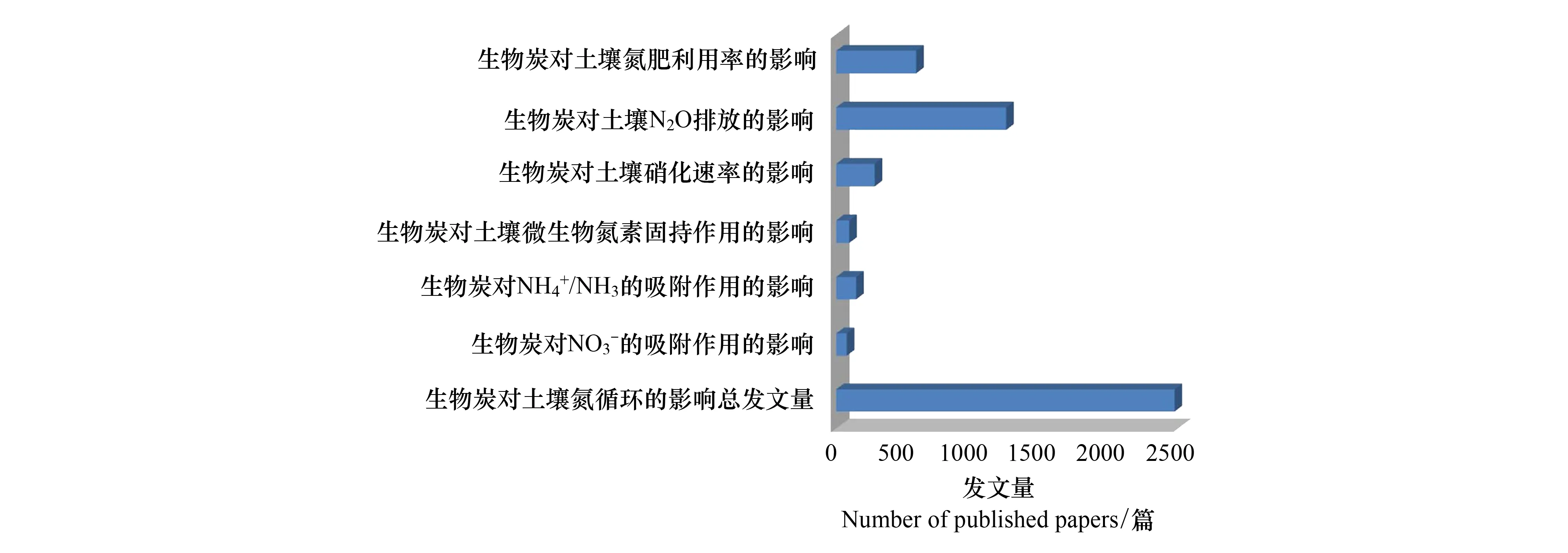
图7 生物炭对土壤氮循环的影响主题分支技术SCI论文量Fig.7 The number of SCI papers of the branch technology about the effect of biochar on the soil nitrogen cycling


图8 生物炭对土壤氮循环的影响主题分支技术SCI论文年代分布Fig.8 The time distribution of SCI papers of the branch technology about the effect of biochar on the soil nitrogen cycling
2.2 研究进展
2.2.1 生物炭对土壤N2O排放的影响
N2O作为产生温室效应的主要组成气体之一,可导致臭氧层破坏。目前,生物炭对土壤N2O排放影响的研究结果争议性很大,有研究表明,添加生物炭能够减少土壤N2O的排放,而也有研究认为,生物炭对土壤N2O排放无影响,甚至促进N2O排放(表3)。

表3 生物炭对土壤N2O排放的影响
生物炭减少N2O排放的作用机制一般认为是生物炭增加了土壤pH,促使反硝化过程中N2O:N2向着有利于产生N2的方向变化[20],也有研究认为是增加了土壤通气性和土壤碳的稳定性[18,22]。Yanai等[22]认为,生物炭对N2O的排放受控于土壤的初始含水孔隙率,含水孔隙率较低的条件下(73%),生物炭能够增强土壤的通气性,降低土壤中的反硝化反应,进而减少N2O的排放;当含水孔隙率增加到83%,生物炭无法通过促进土壤通气性降低土壤反硝化速率,反而会促进N2O的产生。总之,生物炭能够显著影响土壤N2O的排放,而这种影响与生物炭的类型、老化过程以及土壤类型及其含水孔隙率等密切相关[15]。
2.2.2 生物炭对氮肥利用率的影响
随着人们对生物炭认识和研究的不断深入,生物炭在农业生产上的应用也逐渐受到重视(表4)。生物炭提高氮肥利用率[23-24],促进作物增产的作用已得到大量试验证明[25, 17]。然而也有研究表明添加生物炭对作物氮肥利用率没有提高,甚至发生抑制作用[28, 31-32]。

表4 生物炭对氮肥利用率的影响
生物炭提高作物氮肥利用率的作用机理众说纷纭,主要包括生物炭改善了土壤结构,提高了土壤pH值、阳离子交换能力[26]和可利用磷含量[27,33],以及减缓了土壤的铝毒作用等[29-30]。也有研究表明,氮肥在土壤中会发生微生物的固持作用或者被生物炭表面的有机物质吸附[26,33],反而降低了作物的吸氮量。总体而言,尽管生物炭对不同土壤类型、不同作物的氮肥利用率存在差异,但其对土壤肥力的长效作用已经得到普遍认可。
2.2.3 生物炭对土壤硝化速率的影响
生物炭对土壤硝化速率的影响作用结论不一,有研究认为生物炭能够促进土壤硝化速率,而也有研究认为,生物炭会抑制土壤硝化速率,且这种抑制作用受作用时间以及土壤类型等的影响很大(表5)。

表5 生物炭对土壤硝化速率的影响
关于生物炭提高土壤硝化速率的作用机制解释很多,有研究认为,生物炭能够吸附土壤中大量溶解态苯酚和萜烯等抑制硝化反应的化合物[34,40];也有研究认为,生物炭能够抑制土壤中影响硝化细菌群落结构多样性的因子[38],促进土壤中氨氧化细菌的丰富度和活性等[36],进而提高土壤硝化速率。生物炭中含有的对微生物具有毒性作用的化合物(如多环芳烃类)是抑制土壤硝化速率的主要作用机制,但随着生物炭老化过程的延长,能够减弱这种抑制作用[16]。由此可见,生物炭可通过改变土壤微生物活性以及生物炭自身老化等途径影响土壤硝化速率,进而影响土壤供氮水平。


表6 生物炭对/NH3吸附的影响


2.2.6 生物炭对土壤微生物氮素固持作用的影响


表7 生物炭对吸附的影响
综上所述,生物炭对土壤氮循环的影响,既决定于生物炭自身的性质,也决定于特定土壤的理化性质和作物生物学属性等诸多方面,复杂的交互作用及其过程也会使试验结果不尽一致。因此,生物炭应用于农业生产,应该因地、因作物、因具体条件而异。
3 展望
随着科学界对农业面源污染领域的重视,生物炭在土壤氮循环过程中的作用机制受到越来越多的关注,然而,目前已有的相互矛盾的研究结果,充分表明了目前关于生物炭对土壤氮循环影响了解的知识是极为有限的,还存在许多的不确定性和未解决问题,已有的科学结论和问题需要更进一步的研究来验证和丰富,针对“生物炭对土壤氮循环影响”6个分支主题,作者做了以下几点展望:
(1)生物炭具有固碳、减缓全球气候变化和降低温室气体排放等作用,将生物炭对碳氮循环的影响有机结合起来,将为农业发展及环境保护的和谐发展提供可借鉴意义。
(2)已有的短、中期试验结果表明施用生物炭能够提高作物肥料利用率,但目前仍缺少长期定位试验的结论,需要大量的长期监测试验。
(3)不同的研究者关于“生物炭对土壤硝化速率的影响作用研究”得到的结论不同,缺少关键作用机制的研究。如,生物炭对土壤氮相关功能微生物的主要作用机制是什么,生物炭如何影响其硝化和反硝化反应等关键问题仍没有答案。
(4)进一步在大气-土壤-植物生态系统中开展土壤氮素的定性和定量研究,为明确生物炭对土壤微生物氮素固持作用机制提供有力手段。
[1] Sombroek W. Amazon soils: A reconnaissance of the soils of the Brazilian Amazon region [R]. Wageningen: Center for Agricultural Publications and Documentation, 1966.
[2] Lehmann J, Joseph S. Biochar for environmental management: An introduction [M]. In Lehmann J and Joseph S, eds. Biochar for environmental management, science and technology, London: Earthscan Publications Ltd., 2009: 1- 12.
[3] Xie T, Reddy K R, Wang C, Yargicoglu E, Spokas K. Characteristics and applications of biochar for environmental remediation: A review. Critical Reviews in Environmental Science and Technology, 2015, 45: 939- 969.
[4] Liang B, Lehmann J, Solomon D, Kinyangi J, Grossman J, O′Neill B, Skjemstad J O, Thies J, Luizao F J, Petersen J, Neves E G. Black carbon increases cation exchange capacity in soils. Soil Science Society of America Journal, 2006, 70(5): 1719- 1730.
[5] Zhang A, Bian R, Hussain Q, Li L, Pan G, Zheng J, Zhang X, Zheng J. Change in net global warming potential of a rice-wheat cropping system with biochar soil amendment in a rice paddy from China. Agriculture, Ecosystems & Environment, 2013, 173: 37- 45.
[6] Zhai L, CaiJi Z, Liu J, Wang H, Ren T, Gai X, Xi B, Liu H. Short-term effects of maize residue biochar on phosphorus availability in two soils with different phosphorus sorption capacities. Biology and Fertility of Soils, 2015, 51(1): 113- 122.
[7] Van Zwieten L, Kimber S W L, Morris S G, Singh B P, Grace P R, Scheer C, Rust J, Downie A E, Cowie A L. Pyrolysing poultry litter reduces N2O and CO2fluxes. Science of the Total Environment, 2013, 465: 279- 287.
[8] Hu Y, Wu F, Zeng D, Chang S. Wheat straw and its biochar had contrasting effects on soil C and N cycling two growing seasons after addition to a Black Chernozemic soil planted to barley. Biology and Fertility of Soils, 2014, 50: 1291- 1299.
[9] Prommer J, Wanek W, Hofhansl F, Trojan D, Offre P, Urich T, Schleper C, Sassmann S, Kitzler B, Soja G. Biochar decelerates soil organic nitrogen cycling but stimulates soil nitrification in a temperate arable field trial. PLoS ONE, 2014, 9(1).
[10] Cayuela M L, Van Zwieten L, Singh B P, Jeffery S, Roig A, Sanchez-Monedero M A. Biochar′s role in mitigating soil nitrous oxide emissions: A review and meta-analysis. Agriculture, Ecosystems & Environment, 2014, 191:5- 16.
[11] Woolf D, Amonette J E, Stree-Perrott F A, Lehmann J, Joseph S. Sustainable biochar to mitigate global climate change. Nature Communications, 2010, 1: 56.
[12] 吕贻忠,李保国. 土壤学. 北京:中国农业出版社,2006.
[13] Canas-Guerrero I, Mazarron F R, Pou-Merina A, Calleja-Perucho C, Diaz-Rubio G. Bibliometric analysis of research activity in the “Agronomy” category from the Web of Science, 1997- 2011. European Journal of Agronomy, 2013, 50: 19- 28.
[14] Sun J S, Wang M H, Ho Y S. A historical review and bibliometric analysis of research on estuary pollution. Marine Pollution Bulletin, 2012, 64(1): 13- 21.
[15] Singh B P, Hatton B J, Singh B, Cowie A L, Kathuria A. Influence of biochars on nitrous oxide emission and nitrogen leaching from two contrasting soils. Journal of Environmental Quality, 2010, 39(4): 1224- 1235.
[16] Clough T J, Bertram J E, Ray J L, Condron L M, O′Callaghan M, Sherlock R R, Wells N S. Unweathered biochar impact on nitrous oxide emissions from a bovine-urine-amended pasture soil. Soil Science Society of America Journal, 2010, 74(3): 852- 860.
[17] Dong D, Feng Q, McGrouther K, Yang M, Wang H, Wu W. Effects of biochar amendment on rice growth and nitrogen retention in a waterlogged paddy field. Journal of Soils and Sediments, 2015, 15: 153- 162.
[18] Zhang A F, Cui L Q, Pan G X, Li L, Hussain Q, Zhang X, Zheng J, Crowley D. Effect of biochar amendment on yield and methane and nitrous oxide emissions from a rice paddy from Tai Lake plain, China. Agriculture, Ecosystems & Environment, 2010, 139(4): 469- 475.
[19] Rondon M, Ramirez J A, Lehmann J. Charcoal additions reduce net emissions of greenhouse gases to the atmosphere. In Proc. of the 3rd Symp. on Greenhouse Gases and Carbon Sequestration. USDA, Baltimore, MA, 2005: 208.
[20] Cayuela M L, Sànchez-Monederol M A, Roig A, Hanley K, Enders A, Lehmann J. Biochar and denitrification in soils: when, how much and why does biochar reduce N2O emissions? Scientific Reports, 2013, 3(1732): 1- 6.
[21] Verhoeven E, Six J. Biochar does not mitigate field-scale N2O emissions in a Northern California vineyard: an assessment across two years. Agriculture, Ecosystems & Environment, 2014.
[22] Yanai Y, Toyota K, Okazaki M. Effects of charcoal addition on N2O emissions from soil resulting from rewetting air-dried soil in short-term laboratory experiments. Soil Science and Plant Nutrition, 2007, 53(2): 181- 188.
[23] Ma L, Hou Z, Lv N, Ye J, Su S, Liang Y. Effects of biochar application on wheat growth and nitrogen balance. Xinjiang Agricultural Sciences, 2012, 49: 589- 594.
[24] Jones D L, Rousk J, Edwards-Jones G, DeLuca T H, Murphy D V. Biochar-mediated changes in soil quality and plant growth in a three year field trial. Soil Biology and Biochemistry, 2012, 45: 113- 124.
[25] Clough T J, Condron L M. Biochar and the nitrogen cycle: Introduction. Journal of Environmental Quality, 2010, 39: 1218- 1223.
[26] Steiner C, Glaser B, Teixeira W G, Lehmann J, Blum W E H, Zech W. Nitrogen retention and plant uptake on a highly weathered central Amazonian Ferralsol amended with compost and charcoal. Soil Science and Plant Nutrition, 2008, 171(6): 893- 899.
[27] Chan K Y, Van Zwieten L, Meszaros I, Downie A, Joseph S. Using poultry litter biochars as soil amendments. Soil Research, 2008, 46(5): 437- 444.
[28] Van Zwieten L, Kimber S, Morris S, Chan K Y, Downie A, Rust J, Joseph S, Cowie A. Effects of biochar from slow pyrolysis of paper mill waste on agronomic performance and soil fertility. Plant and Soil, 2010, 327(1/2): 235- 246.
[29] Zhu Q, Peng X, Huang T, Xie Z. Holden N M. Effect of biochar addition on maize growth and nitrogen use efficiency in acidic red soils. Pedosphere, 2014, 24, 699- 708.
[30] Rajkovich S, Enders A, Hanley K, Hyland C, Zimmerman A R, Lehmann J. Corn growth and nitrogen nutrition after additions of biochars with varying properties to a temperate soil. Biology and Fertility of Soils, 2012, 48: 271- 284.
[31] Major J, Rondon M, Molina D, Riha S J, Lehmann J. Maize yield and nutrition during 4 years after biochar application to a Colombian savanna oxisol. Plant and Soil, 2010, 333(1/2): 117- 128.
[32] Gaskin J W, Speir R A, Harris K, Das K C, Lee R D, Morris L A, Fisher D S. Effect of peanut hull and pine chip biochar on soil nutrients, corn nutrient status, and yield. Agronomy Journal, 2010, 102: 623- 633.
[33] Chan K Y, Van Zwieten L, Meszaros I, Downie A, Joseph S. Agronomic values of green waste biochar as a soil amendment. Soil Research, 2007, 45(8): 629- 634.
[34] Berglund L M, DeLuca T H, Zackrisson O. Activated carbon amendments of soil alters nitrification rates in Scots pine forests. Soil Biology and Biochemistry, 2004, 36(12): 2067- 2073.
[35] Ball P N, MacKenzie M D, DeLuca T H, Holben W E. Wildfire and charcoal enhance nitrification and ammonium-oxidizing bacterial abundance in dry montane forest soils. Journal of Environmental Quality, 2010, 39(4): 1243- 1253.
[36] Song Y, Zhang X, Ma B, Chang S, Gong J. Biochar addition affected the dynamics of ammonia oxidizers and nitrification in microcosms of a coastal alkaline soil. Biology and Fertility of Soils, 2014, 50: 321- 332
[37] Nelissen V, Rütting T, Huygens D, Staelens J, Ruysschaert G, Boeckx P. Maize biochars accelerate short-term soil nitrogen dynamics in a loamy sand soil. Soil Biology and Biochemistry, 2012, 55:20- 27.
[38] Deluca T H, Mackenzie M D, Gundale M J, Holben W E. Wildfire-produced charcoal directly influences nitrogen cycling in ponderosa pine forests. Soil Science Society of America Journal, 2006, 70(2): 448- 453.
[39] Cheng Y, Cai Z, Chang S X, Wang J, Zhang J. Wheat straw and its biochar have contrasting effects on inorganic N retention and N2O production in a cultivated Black Chernozem. Biology and Fertility of Soils, 2012, 48: 941- 946
[40] Paavolainen L, KitunenV, Smolander A. Inhibition of nitrification in forest soil by monoterpens. Plant and Soil, 1998, 205(2): 147- 157.
[41] Ding Y, Liu Y, Wu W, Shi D, Yang M, Zhong Z. Evaluation of biochar effects on nitrogen retention and leaching in multi-layered soil columns. Water air and soil pollution, 2010, 213(1/4): 47- 55.
[42] Yao Y, Gao B, Zhang M, Inyang M, Zimmerman A R. Effect of biochar amendment on sorption and leaching of nitrate, ammonium, and phosphate in a sandy soil. Chemosphere, 2012, 89(11): 1467- 1471.
[43] Gai X, Wang H, Liu J, Zhai L, Liu S, Ren T, Liu H. Effects of feedstock and pyrolysis temperature on biochar adsorption of ammonium and nitrate. 2014. PLoS ONE, 9(12).
[44] 刘玮晶, 刘烨, 高晓荔, 杨旻, 王英惠, 代静玉. 外源生物质炭对土壤中铵态氮素滞留效应的影响. 农业环境科学学报, 2012, 31(5): 962- 968.
[45] 邢英, 李心清, 王兵. 生物炭对黄壤中氮淋溶影响:室内土柱模拟. 生态学杂志, 2011, 30(11): 2483- 2488.
[46] Iyobe T, Asada T, Kawata K, Oikawa K. Comparison of removal efficiencies for ammonia and amine gases between woody charcoal and activated carbon. Journal of Health Science, 2004, 50(2): 148- 153.
[47] Kastner J R, Miller J, Das K C. Pyrolysis conditions and ozone oxidation effects on ammonia adsorption in biomass generated chars. Journal of Hazardous Materials, 2009, 164(2/3): 1420- 1427.
[48] Hollister C C, Bisogni J J, Lehmann J. Ammonium, nitrate, and phosphate sorption to and solute leaching from biochars prepared from corn stover (Zea mays L.) and oak wood (Quercus spp.). Journal of Environmental Quality, 2013, 42(1): 137- 144.
[49] Cheng C H, Lehmann J, Thies J E, Burton S D, Engelhard M H. Oxidation of black carbon by biotic and abiotic processes. Organic Geochemistry, 2006, 37(11): 1477- 1488.
[50] Silber A, Levkovitch I, Graber E R. pH-dependent mineral release and surface properties of cornstraw biochar: agronomic implications. Environmental Science & Technology, 2010, 44(24): 9318- 9323.
[51] Nguyen B T, Lehmann J. Black carbon decomposition under varying water regimes. Organic Geochemistry, 2009, 40(8): 846- 853.
[52] Asada T, Ishihara S, Yamane S, Toba A, Yamada A, Oikawa K. Science of bamboo charcoal: Study of carbonizing temperature of bamboo charcoal and removal capability of harmful gases. Journal of Health Science, 2002, 48(6): 473- 479.
[53] Asada T, Ohkubo T, Kawata K, Oikawa K. Ammonia adsorption on bamboo charcoal with acid treatment. Journal of Health Science, 2006, 52(5): 585- 589.
[54] Clough T J, Condron L M, Kammann C, Müller C. A review of biochar and soil nitrogen dynamics. Agronomy, 2013, 3(2): 275- 293.
[56] Zheng H, Wang Z, Deng X, Herbert S, Xing B. Impacts of adding biochar on nitrogen retention and bioavailability in agricultural soil. Geoderma, 2013, 206: 32- 39.
[57] Dempster D N, Jones D L, Murphy D V. Clay and biochar amendments decreased inorganic but not dissolved organic nitrogen leaching in soil. Soil Research, 2012, 50(3): 216- 221.
[58] Kameyama K, Miyamoto T, Shiono T, Shinogi Y. Influence of sugarcane bagasse-derived biochar application on nitrate leaching in calcaric dark red soil. Journal of Environmental Quality, 2012, 41(4): 1131- 1137.
[59] Mizuta K, Matsumoto T, Hatate Y, Nishihara K, Nakanishi T. Removal of nitrate-nitrogen from drinking water using bamboo powder charcoal. Bioresource Technology, 2004, 95(3): 255- 257.
[60] Ohe K, Nagae Y, Nakamura S, Baba Y. Removal of nitrate anion by carbonaceous materials prepared by bamboo and coconut shell. Journal of Chemical Engineering of Japan, 2003, 36(4): 511- 515.
[61] 盖霞普, 刘宏斌, 翟丽梅, 王洪媛. 玉米秸秆生物炭对土壤无机氮素淋失风险的影响研究. 农业环境科学学报, 2015, (34)2: 310- 318.
[62] Al-Wabel M I, Al-Omran A, El-Naggar A H, Nadeem M, Usman A R A. Pyrolysis temperature induced changes in characteristics and chemical composition of biochar produced from conocarpus wastes. Bioresource Technology, 2013, 131: 374- 379.
[63] Eykelbosh A J, Johnson M S, Couto E G. Biochar decreases dissolved organic carbon but not nitrate leaching in relation to vinasse application in a Brazilian sugarcane soil. Journal of Environmental Management, 2015, 149: 9- 16.
[64] Cheng C H, Lehmann J. Ageing of black carbon along a temperature gradient. Chemosphere, 2009, 75(8): 1021- 1027.
[65] DeLuca T H, MacKenzie M D, Gundale M J. Biochar effects on soil nutrient transformations. In Lehmann J and Joesph S, eds. Biochar for environmental management, science and technology. London: Earthscan Publications Ltd., 2009: 251- 270.
[66] Smith J L, Collins H P, Bailey V L. The effect of young biochar on soil respiration. Soil Biology and Biochemistry, 2010, 42(12): 2345- 2347.
[67] Bruun E W, Ambus P, Egsgaard H, Hauggaard-Nielsen H. Effects of slow and fast pyrolysis biochar on soil C and N dynamics. Soil Biology and Biochemistry, 2012, 46: 73- 79.
[68] Prayogo C, Jones J E, Baeyens J, Bending G. Impact of biochar on mineralization of C and N from soil and willow litter and its relationship with microbial community biomass and structure. Biology and Fertility of Soils, 2014, 50: 695- 702.
[69] Zackrisson O, Nilsson M C, Wardle D A. Key ecological function of charcoal from wildfire in the boreal forest. Oikos, 1996, 77: 10- 19.
[70] Kuzyakov Y, Subbotina I, Chen H, Bogomolova I, Xu X. Black carbon decomposition and incorporation into soil microbial biomass estimated by14C labelling. Soil Biology and Biochemistry, 2009, 41(4): 210- 219.
[71] Bruun S, Jensen E S, Jensen L S. Microbial mineralization and assimilation of black carbon: Dependency on degree of thermal alteration. Organic Geochemistry, 2008, 39(7): 839- 845.
[72] Major J, Rondon M, Molina D, Riha S, Lehmann J. Nutrient leaching in a Colombian savanna Oxisol amended with biochar. Journal of Environmental Quality, 2012, 41: 1076- 1086.
Effect of biochar on soil nitrogen cycling: a review
WANG Hongyuan, GAI Xiapu, ZHAI Limei, LIU Hongbin*
KeyLaboratoryofNonpointSourcePollutionControl,MinistryofAgriculture/InstituteofAgriculturalResourcesandRegionalPlanning,ChineseAcademyofAgriculturalSciences,Beijing100081,China

to agriculture application for biochar.
biochar; soil nitrogen cycling; literature retrieval metrology
公益性行业(农业)科研专项经费项目(201303095);国家自然科学基金资助项目(41301311)
2014- 12- 05;
日期:2016- 01- 15
10.5846/stxb201412052414
*通讯作者Corresponding author.E-mail: liuhongbin@caas.cn
王洪媛, 盖霞普, 翟丽梅, 刘宏斌.生物炭对土壤氮循环的影响研究进展.生态学报,2016,36(19):5998- 6011.
Wang H Y, Gai X P, Zhai L M, Liu H B.Effect of biochar on soil nitrogen cycling: a review.Acta Ecologica Sinica,2016,36(19):5998- 6011.
